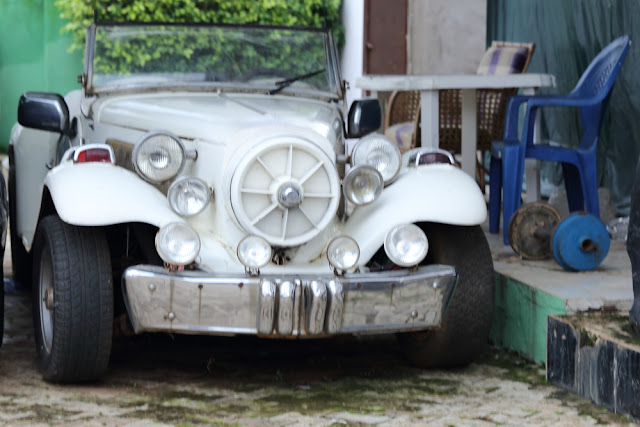 |
| Prof. (Sir) Victor Uwaifo playing Joromi |
Prof. Victor Uwaifo is one of the musical legends of Nigeria. He was the first African to win a Record Golden Disc in Africa with a music title called Joromi back in 1966. He spearheaded Highlife music in his own way and represented Nigeria at Festac, Black and Arts festival, in 1977 in Lagos.
Music has always occupied a large part of his life but Prof. is also known to be a man of many talents. He was a good sportsman and he diversified his career by studying arts and sculpture in particular. He has taught for years at Uniben (the University of Benin City) and obtained a PhD in that field in the late 1990s.
 |
| Victor Uwaifo representing Nigeria at Festac 77 |
The palazzo contains a museum looking like an underground labyrinth. Before entering a patio containing sculptures depicting ancient Benin historical events, our guide introduced the sculptures at the door: two men, one in traditional attire inherited from the missionaries and another one wearing a more african-looking robe, in the style of a roman toga, with a necklace of coral beads. Next to those statues is a lion tamed by a blonde-looking caucasian women with naked breast protruding out of her scanty dress, it would be an allegory of colonialism with European coming with attractive ideas and goods to subvert the African lion.
In the patio, there is a representation of Prince Odogbo. His father was the Oba of Benin at the end of the 16th century AD. Benin applied primogeniture to pass on royal charges (the elder son inherits the functions of his father). Prince Odogbo was a feminine looking young man so his father ordered that after his death the Prince should walk naked to unveil his manhood to everyone so that he could succeed to his father as Oba of Benin.
Inside the museum, one starts with a few objects from Victor's youth, his bicycle, a phonograph from his parents' house. From there, a long corridor, leading to a room displaying all the post independence presidents from Nigeria, contains images of Victor as a young boy, then as a young and successful musician, notably the poster of Festac 77 where he represented Nigeria. There are also fiberglass sculptures of chained slaves. Other rooms, include a televised installation on the execution to death of a famous gang terrorising the region of Benin, a collection of Ukughe -wooden sticks containing the spirit of an ancestor - and representations of traditional legendary spiritual figures. A statue of Victor Uwaifo playing guitar was surrounded by a colourful serie of his best stage suits and guitars, among which the keyboard-guitar instrument he claims to have invented. Then comes his music recording studio and an access to the concrete plane. The encounter of Victor and the river goddess was materialised in a corner where Victor was lying in a river playing guitar to the Goddess erected in front of him. That last room had representation of what happened to people who lacked respect to the royal protocol and had to be disposed of, beheaded or hung in the nearby forest.
 |
| Victor Uwaifo is having an esoteric encounter with the River Goddess |
 |
| Victor Uwaifo's selected guitars and outfits |
 |
| Victor Uwaifo's Vision 01 |
Comments
Post a Comment